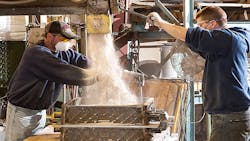The U.S. Department of Labor’s Occupational Safety and Health Administration issued a final rule on Occupational Exposure to Respirable Crystalline Silica, establishing workplace safety standards for employees exposed to silica, or silicon dioxide, a hazardous material that is a byproduct of numerous industrial processes, including metalcasting. Exposure to silica/silicon dioxide can cause silicosis, lung cancer, other respiratory diseases and kidney disease.
OSHA stated its new rule would curb lung cancer, silicosis, chronic obstructive pulmonary disease and kidney disease, and projected it would save more than 600 lives per year. It also predicted the new rule would prevent more than 900 new cases of silicosis annually, and that it would provide net benefits of about $7.7 billion per year.
OSHA first proposed a new rule in 2013, but the final ruling was delayed as industry groups sought more information and further input to the regulatory process. The former standard had been in place since 1971, according to the agency.
“The previous exposure limits were outdated and did not adequately protect workers,” stated assistant Secretary of Labor for Occupational Safety and Health Dr. David Michaels. “Limiting exposure to silica dust is essential. Every year, many exposed workers not only lose their ability to work, but also to breathe.”
According to OSHA estimates, 2.3 million men and women each year face exposure to respirable crystalline silica in their workplaces. That estimate includes 2 million and 300,000 workers in other operations, including foundries.
In addition to foundries, where molding sand is the primary source of silica exposure, the new rule is expected to impact glassmaking and sand blasting, and construction operations where cutting, sawing, drilling and crushing of concrete, brick, block or other stone products takes place.
Silica exposure is also a concern in oil-and-natural gas exploration and some of its supplier industries, as sands used in hydraulic fracturing (“fracking”) may present an exposure hazard.
The agency asserted that most employers would be able to limit exposure to silica dust by using available equipment, including using water to keep dust from entering the air or ventilation systems.
OSHA said the final rule would improve worker protection by reducing the permissible exposure limit for crystalline silica to 50 micrograms per cubic meter of air, averaged over an eight-hour shift. It also requires employers to use engineering controls (e.g., water or ventilation) and work practices to limit worker exposure; provide respiratory protection when controls cannot limit exposures to the permissible level; limit access to high exposure areas; train workers; and provide medical exams to highly exposed workers.
OSHA contended the new rule would provide “greater certainty and ease of compliance” to small business employers, especially construction firm, by providing a table of specified controls they can follow to achieve compliance without having to monitor exposures.
Also, OSHA has “staggered” the new rule’s compliance dates to give employers sufficient time to meet the requirements. In fact, there are two compliance standards: one for construction and one for general industry and maritime businesses. Construction industry employers have until June 23, 2017, to achieve compliance with most new requirements. For general industry and maritime businesses, employers have until June 23, 2018 to comply with most requirements.
OSHA also allowed additional time for employers to offer medical exams to some workers; for fracking business employers to install dust controls to meet the new exposure limit; and for all general industry employers to offer medical surveillance to employees exposed between the personal exposure limit (PEL) and 50 micrograps/cubic meter, and the action level of 25 micrograms per cubic meter.
U.S. Secretary of Labor Thomas E. Perez stated: “This rule will save lives. It will enable workers to earn a living without sacrificing their health. It builds upon decades of research and a lengthy stakeholder engagement process – including the consideration of thousands of public comments – to finally give workers the kind of protection they deserve …”
About the Author
Robert Brooks
Content Director
Robert Brooks has been a business-to-business reporter, writer, editor, and columnist for more than 20 years, specializing in the primary metal and basic manufacturing industries. His work has covered a wide range of topics, including process technology, resource development, material selection, product design, workforce development, and industrial market strategies, among others.
